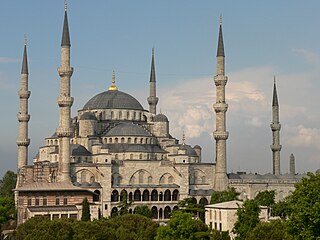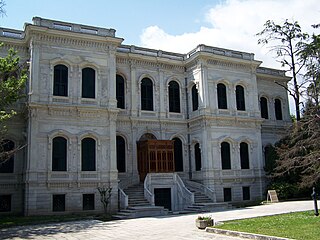
There are many landmarks in Istanbul. The historic areas of Istanbul are cited as UNESCO World Heritage Site.

There are many landmarks in Istanbul. The historic areas of Istanbul are cited as UNESCO World Heritage Site.

Mehmed III was the sultan of the Ottoman Empire from 1595 until his death in 1603. Mehmed was known for ordering the execution of his brothers and leading the army in the Long Turkish War, during which the Ottoman army was victorious at the decisive Battle of Keresztes. This victory was however undermined by some military losses such as in Gyor and Nikopol. He also ordered the successful quelling of the Jelali rebellions. The sultan also communicated with the court of Elizabeth I on the grounds of stronger commercial relations and in the hopes of England to ally with the Ottomans against the Spanish.

Edirne, historically known as Adrianople, is a city in Turkey, in the northwestern part of the province of Edirne in Eastern Thrace. Situated 7 km (4.3 mi) from the Greek and 20 km (12 mi) from the Bulgarian borders, Edirne was the second capital city of the Ottoman Empire from 1369 to 1453, before Constantinople became its capital.

Üsküdar is a municipality and district of Istanbul Province, Turkey. Its area is 35 km2, and its population is 524,452 (2022). It is a large and densely populated district on the Anatolian (Asian) shore of the Bosphorus. It is bordered to the north by Beykoz, to the east by Ümraniye, to the southeast by Ataşehir and to the south by Kadıköy; with Karaköy, Kabataş, Beşiktaş, and the historic city center of Fatih facing it on the opposite shore to the west. Üsküdar has been a conservative cultural center of the Anatolian side of Istanbul since Ottoman times with its numerous historic landmark and little mosques and dergahs.

Mimar Sinan also known as Koca Mi'mâr Sinân Âğâ, was the chief Ottoman architect, engineer and mathematician for sultans Suleiman the Magnificent, Selim II and Murad III. He was responsible for the construction of more than 300 major structures, including the Selimiye Mosque in Edirne, the Kanuni Sultan Suleiman Bridge in Büyükçekmece, and the Mehmed Paša Sokolović Bridge in Višegrad, as well as other more modest projects such as madrasa's, külliyes, and bridges. His apprentices would later design the Sultan Ahmed Mosque in Istanbul and the Stari Most bridge in Mostar.

Beşiktaş is a district and municipality of Istanbul Province, Turkey. Its area is 18 km2 and its population is 175,190 (2022). It is located on the European shore of the Bosphorus strait. It is bordered on the north by Sarıyer and Şişli, on the west by Kağıthane and Şişli, on the south by Beyoğlu, and on the east by the Bosphorus. Directly across the Bosphorus is the district of Üsküdar.

Beyoğlu is a municipality and district of Istanbul Province, Turkey. Its area is 9 km2, and its population is 225,920 (2022). It is on the European side of Istanbul, Turkey, separated from the old city by the Golden Horn. It was known as the region of Pera surrounding the ancient coastal town Galata which faced Constantinople across the Horn. Beyoğlu continued to be named Pera during the Middle Ages and, in western languages, into the early 20th century.

Nurbanu Sultan was Haseki Sultan of the Ottoman Empire and the legal wife of Sultan Selim II, as well as Valide Sultan as the mother of Sultan Murad III. She was one of the most prominent figures during the time of the Sultanate of Women. Conflicting theories describe her as of Venetian, Jewish or Greek origin. Her birth name may have been Cecilia Venier-Baffo, Rachel or Kalē Kartanou.

Ottoman architecture is an architectural style or tradition that developed under the Ottoman Empire over a long period, undergoing some significant changes during its history. It first emerged in northwestern Anatolia in the late 13th century and developed from earlier Seljuk Turkish architecture, with influences from Byzantine and Iranian architecture along with other architectural traditions in the Middle East. Early Ottoman architecture experimented with multiple building types over the course of the 13th to 15th centuries, progressively evolving into the classical Ottoman style of the 16th and 17th centuries. This style was a mixture of native Turkish tradition and influences from the Hagia Sophia, resulting in monumental mosque buildings focused around a high central dome with a varying number of semi-domes. The most important architect of the classical period is Mimar Sinan, whose major works include the Şehzade Mosque, Süleymaniye Mosque, and Selimiye Mosque. The second half of the 16th century also saw the apogee of certain decorative arts, most notably in the use of Iznik tiles.

The Balyan family was a prominent Armenian family in the Ottoman Empire of court architects in the service of Ottoman sultans and other members of the Ottoman dynasty during the 18th and 19th centuries. For five generations, they designed and constructed numerous major buildings in the Ottoman Empire, including palaces, mansions, konaks, kiosks, yalis, mosques, churches, and various public buildings, mostly in Constantinople.

Yıldız Palace is a vast complex of former imperial Ottoman pavilions and villas in Beşiktaş, Istanbul, Turkey, built in the 19th and early 20th centuries. It was used as a residence by the sultan and his court in the late 19th century.

The architecture of Istanbul describes a large mixture of structures which reflect the many influences that have made an indelible mark in all districts of the city. The ancient part of the city is still partially surrounded by the Walls of Constantinople, erected in the 5th century by Emperor Theodosius II to protect the city from invasion. The architecture inside the city proper contains buildings and structures which came from Byzantine, Genoese, Ottoman, and modern Turkish sources. The city has many architecturally significant entities. Throughout its long history, Istanbul has acquired a reputation for being a cultural and ethnic melting pot. As a result, there are many historical mosques, churches, synagogues, palaces, castles and towers to visit in the city.

The following outline is provided as an overview of and topical guide to the Ottoman Empire:
The following is a timeline of the history of the town of Istanbul, Turkey.

The following outline is provided as an overview of and topical guide to Istanbul:

Classical Ottoman architecture is a period in Ottoman architecture generally including the 16th and 17th centuries. The period is most strongly associated with the works of Mimar Sinan, who was Chief Court Architect under three sultans between 1538 and 1588. The start of the period also coincided with the long reign of Suleiman the Magnificent, which is recognized as the apogee of Ottoman political and cultural development, with extensive patronage in art and architecture by the sultan, his family, and his high-ranking officials.

This article covers the history of Ottoman architecture from the 19th century up to the end of the Ottoman Empire in the early 20th century. The 19th century saw architectural influences from Western Europe increase. The Ottoman Baroque style, which emerged in the 18th century, continued to be evident in the early 19th century under the reigns of Selim III and Mahmud II. Empire style and Neoclassical motifs also began to be introduced around this time. Subsequently, a trend towards eclecticism became prominent in many types of buildings, particularly during the Tanzimat period, as exemplified by the Dolmabaçe Palace and other mosques of this era designed by architects of the Balyan family.